Theater aan de Parade

| Kategorie | Projekty veřejného zájmu |
|---|---|
| Rok | 2023 |
| Země | Benelux |
| Organizace | Mertens Bouwbedrijf Weert |
| Autor | Luc Thomassen |
| Spoluautoři | Huys Liggers Venlo (uitbesteed Samenstel/las werk), Van Moll Engineering (model sharing), Coatinc Roermond (spuitwerk), WeCoat Stramproy (verzinken) en Van de Laar B.V. (statische berekeningen) |
| Klient | Gemeente Den Bosch |
| Místo stavby | Den Bosch |
| Tags |
Het project omvat de ver- / nieuwbouw van het Theater a/d Parade in ’s-Hertogenbosch. Uitgangspunt vanuit het ontwerp was het gedeeltelijk in stand houden van de bestaande betonconstructie uit de jaren ’70, dit met het oogpunt op duurzaamheid. Naast de keldervloer en -wanden moest ook de betonconstructie van de grote zaal in tact blijven tijdens de sloop van de overige bouwdelen. Hiervoor zijn op een 3-tal posities tijdelijke staalconstructies voorzien, om de stabiliteit van de bestaande constructie te waarborgen.
Nadat de sloopfase was afgerond is gestart met het opbouwen van de nieuwe constructie, dit begon met het aanbrengen van 129 st. jetgroutpalen onder de bestaande keldervloer. Langs en over het karkas van de grote zaal is vervolgens een nieuwe staalconstructie geplaatst incl. 4 grote vakwerkspanten van elke ruim 20m lang en een gewicht van ruim 7ton t.b.v. de nieuwe dakconstructie.
Achter de grote zaal is de toneeltoren in z’n geheel opnieuw opgebouwd, deze constructie bestaat uit een combinatie van staal en beton. In de achterwand van de toneeltoren staan 5 st. HEB800 kolommen (met elk een hoogte van bijna 22m), waarop vakwerken rusten van elk bijna 20m lang en een gewicht van ruim 9 ton. Deze vakwerken dragen zowel de kanaalplaten van het dak als de lamellenvloer van de rollenzolder t.b.v. theatertechniek. Naast de grote zaal met toneeltoren bevat dit gebouw ook nog een middenzaal, met in hoogte verstelbare vloeren en uitschuifbare tribunes. Zo is deze zaal geschikt voor zowel een theatervoorstelling als de beroemde Oeteldonkse carnaval. Deze constructie is als doos-in-doos is uitgevoerd (zowel de staalconstructie als de vloer van de binnendoos zijn akoestisch ontkoppeld t.o.v. de omliggende betonconstructie) waardoor beide zalen gelijktijdig gebruikt kunnen worden.
Bijzonder aan dit project is de integraliteit met de vele installaties, denk hierbij niet alleen aan complexe gebouwinstallaties welke nodig zijn voor een theater maar vooral ook de vele theatertechnische installaties. Zo is de middenzaal voorzien van een heffer, waarmee een complete vrachtwagencombinatie van 10 ton inpandig zo’n 4,5m omhoog kan worden gebracht. Hierdoor kunnen de rekwisieten direct vanuit de oplegger naar het podium worden verplaatst, zonder overbrugging van hoogteverschillen. De bevoorrading van de grote zaal gaat plaatsvinden d.m.v. een schuifplateau waarop een 2-tal vrachtwagencombinaties van buiten het gebouw naar binnen geschoven kunnen worden, zodat ook hier het in- en uitladen achter gesloten deuren kan plaatsvinden (dus zonder overlast voor de omgeving).
De gehele staalconstructie van ruim 900 ton is uitgevoerd in gevolgklasse CC3 met een unity-check van 0,83 op de door de ontwerpend constructeur aangewezen sleutel-elementen. Naast de eerder genoemde kolommen en vakwerkspanten bevat het project ook nog diverse trappen en hekwerken, met als eyecatcher de hoofdtrap in het hart van het gebouw. Deze trap verbindt de kelder naar de begane grond en 1e verdieping, het totale gewicht bedraagt maar liefst ruim 22 ton.
Naast de staalconstructie zijn ook de betonconstructie, gebouwinstallaties (E – W – S), theatertechnische installaties, bouwkundige afwerkingen en diverse grote onderdelen (bijv. vloeren, prefab trappen en prefab gevelelementen) in 3D uitgewerkt en zijn deze IFC-modellen samengevoegd in een totaalmodel. Hiervoor wordt gebruikt gemaakt van Dalux, waarmee zowel de IFC-modellen als overige documenten op een centrale en eenvoudige wijze worden gedeeld.
The project includes the renovation and new construction of the Theater aan de Parade in ‚s-Hertogenbosch. The starting point of the design was to partially maintain the existing concrete structure from the 1970s, with a view to sustainability. Besides the basement floor and walls, the concrete structure of the main hall also had to remain intact during the demolition of the other parts of the building. To this end, temporary steel structures were provided at three positions to ensure the stability of the existing structure.
After the demolition phase was completed, work began on building the new structure, which began with the installation of 129 st. jet grout piles under the existing basement floor. A new steel structure was then placed along and over the carcass of the main hall including 4 large trusses, each over 20m long and weighing over 7 tons, for the new roof structure.
Behind the main hall, the stage tower was completely rebuilt, consisting of a combination of steel and concrete. In the back wall of the stage tower are 5 st. HEB800 columns (each with a height of almost 22m), resting on trusses, each almost 20m long and weighing over 9 tons. These trusses support both the hollow-core slabs of the roof and the slatted floor of the roller loft for theater technology. In addition to the large auditorium with a stage tower, this building also contains a center hall, with height-adjustable floors and retractable bleachers. Thus, this hall is suitable for both a theater performance and the famous Oeteldonk carnival. This construction is designed as a box-in-box (both the steel construction and the floor of the inner box are acoustically decoupled from the surrounding concrete construction) so that both halls can be used simultaneously.
Special about this project is the integrality with the many installations, not only the complex building installations required for a theater, but also the many technical theater installations. For example, the central auditorium is equipped with a lifter, with which a complete truck combination of 10 tons can be raised about 4.5 m indoors. This allows props to be moved directly from the trailer to the stage without bridging height differences. Supplying the large auditorium will take place by means of a sliding platform on which two articulated lorries can be moved in from outside the building, so that loading and unloading can also take place behind closed doors (without disturbing the surroundings).
The entire steel structure of over 900 tons was constructed in consequence class CC3 with a unity check of 0.83 on the key elements designated by the designing structural engineer. In addition to the aforementioned columns and trusses, the project also includes various stairs and railings, with the main staircase at the heart of the building as the eye-catcher. This staircase connects the basement to the ground and 1st floors, the total weight is no less than over 22 tons.
In addition to the steel structure, the concrete structure, building installations (E – W – S), theatrical installations, architectural finishes and various large components (e.g. floors, precast stairs and precast facade elements) were also worked out in 3D and these IFC models were merged into a total model. Dalux is used for this purpose, with which both the IFC models and other documents are shared centrally and easily.
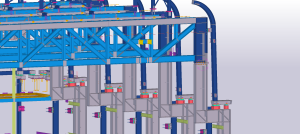
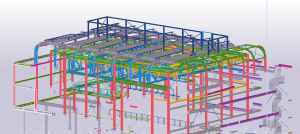
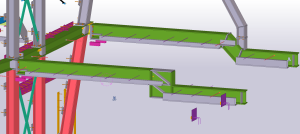
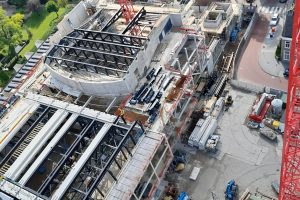

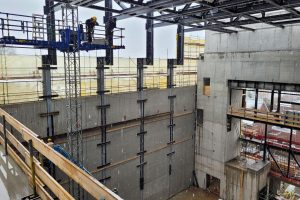
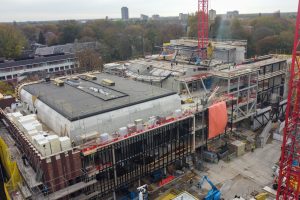
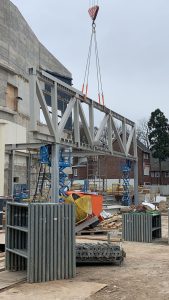
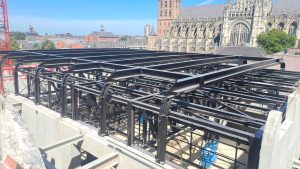
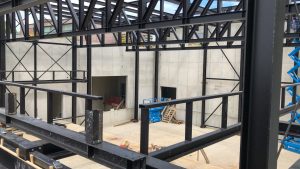
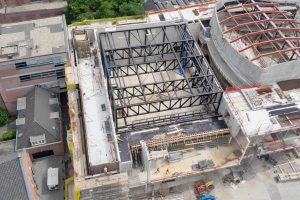
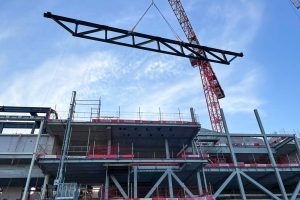

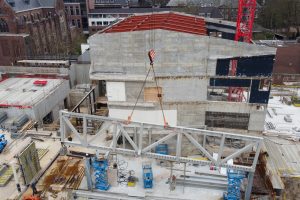
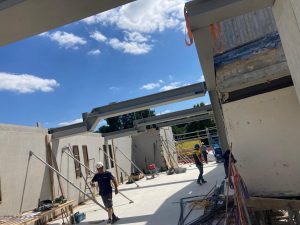
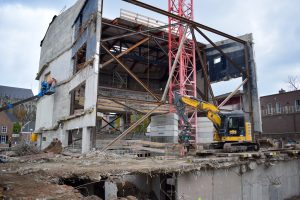


Mooi project
INDRUKWEKKEND! Complimenten voor deze professionele en enthousiaste bouwers van Mertens!
informatie over de BIM Awards is hier terug te vinden: https://www.mertens-weert.nl/nieuws/theater-aan-de-parade-wint-construsoft-bim-awards-2023/